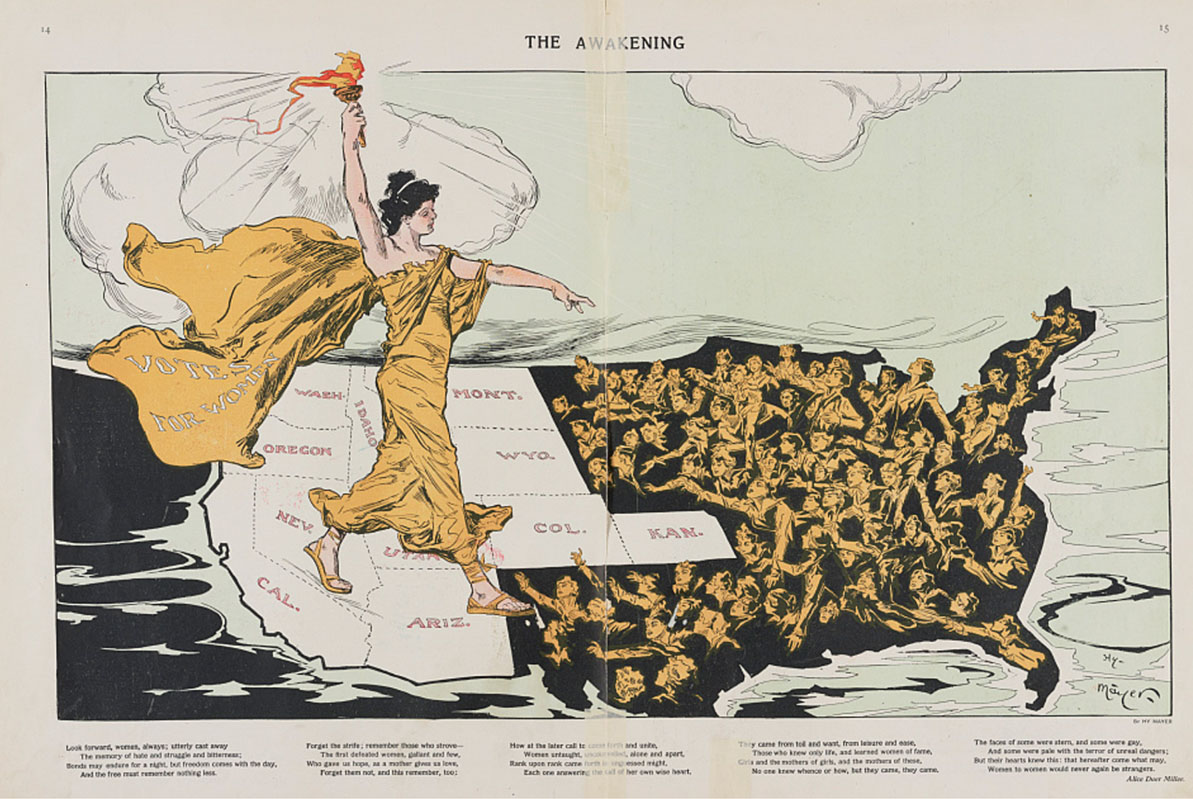Module 5: Leading the Way: The Progressive Movement, 1890-1920
Section outline
-
 Image from Chapter 21 in U.S. History (opens in new window) from OpenStax, licensed under Creative Commons Attribution License v4.0 with the image information: The western states were the first to allow women the right to vote, a freedom that grew out of the less deeply entrenched gendered spheres in the region. This illustration, from 1915, shows a suffragist holding a torch over the western states and inviting the beckoning women from the rest of the country to join her.This module explores the Progressive Movement from 1890-1920. In its first decade, the Progressive Era was a grassroots effort that ushered in reforms at state and local levels. At the beginning of the twentieth century, however, Progressive endeavors captured the attention of the federal government. Progressive campaigns stretched from the hurricane-ruined townships of Texas to the slums of New York, from the factory floor to the saloon door. But what tied together these disparate causes and groups was the belief that the country was in dire need of reform. The Progressive commitment to promoting democracy and social justice created an environment within which the movements for women’s and African American rights grew and flourished. Theodore Roosevelt's activism in the executive branch spoke to the Progressive spirit in the nation and transformed the president’s office for the twentieth century.Upon completion of this module, you will be able to:
Image from Chapter 21 in U.S. History (opens in new window) from OpenStax, licensed under Creative Commons Attribution License v4.0 with the image information: The western states were the first to allow women the right to vote, a freedom that grew out of the less deeply entrenched gendered spheres in the region. This illustration, from 1915, shows a suffragist holding a torch over the western states and inviting the beckoning women from the rest of the country to join her.This module explores the Progressive Movement from 1890-1920. In its first decade, the Progressive Era was a grassroots effort that ushered in reforms at state and local levels. At the beginning of the twentieth century, however, Progressive endeavors captured the attention of the federal government. Progressive campaigns stretched from the hurricane-ruined townships of Texas to the slums of New York, from the factory floor to the saloon door. But what tied together these disparate causes and groups was the belief that the country was in dire need of reform. The Progressive commitment to promoting democracy and social justice created an environment within which the movements for women’s and African American rights grew and flourished. Theodore Roosevelt's activism in the executive branch spoke to the Progressive spirit in the nation and transformed the president’s office for the twentieth century.Upon completion of this module, you will be able to:- Describe the role that muckrakers played in catalyzing the Progressive Era (CO 1-7)
- Explain the main features of Progressivism (CO 1-5)
- Identify specific examples of grassroots Progressivism relating to the spread of democracy, efficiency in government, and social justice (CO 1-7)
- Describe the more radical movements associated with the Progressive Era (CO 1-5)
- Understand the origins and growth of the women’s rights movement (CO 1-7)
- Identify the different strands of the early African American civil rights movement (CO 1-5)
- Explain the key features of Theodore Roosevelt’s “Square Deal” (CO 1-5)
- Explain the key features of William Howard Taft’s Progressive agenda (CO 1-5)
- Identify the main pieces of legislation that Woodrow Wilson’s “New Freedom” agenda comprised (CO 1-7)
To achieve these objectives:
- Read the Module 5 Introduction above.
- Read and view the materials in Module 5 (click below)
- View the Module 5 PowerPoint below.
- Complete Module 5 quizzes/assignments/discussion boards based on chapter/document reading.
Module Pressbooks Resources and Activities
You will find the following resources and activities in this module at the Pressbooks website. Click on the links below to access or complete each item.
Background Colour
Font Face
Font Kerning
Font Size
Image Visibility
Letter Spacing
Line Height
Link Highlight
Text Colour
